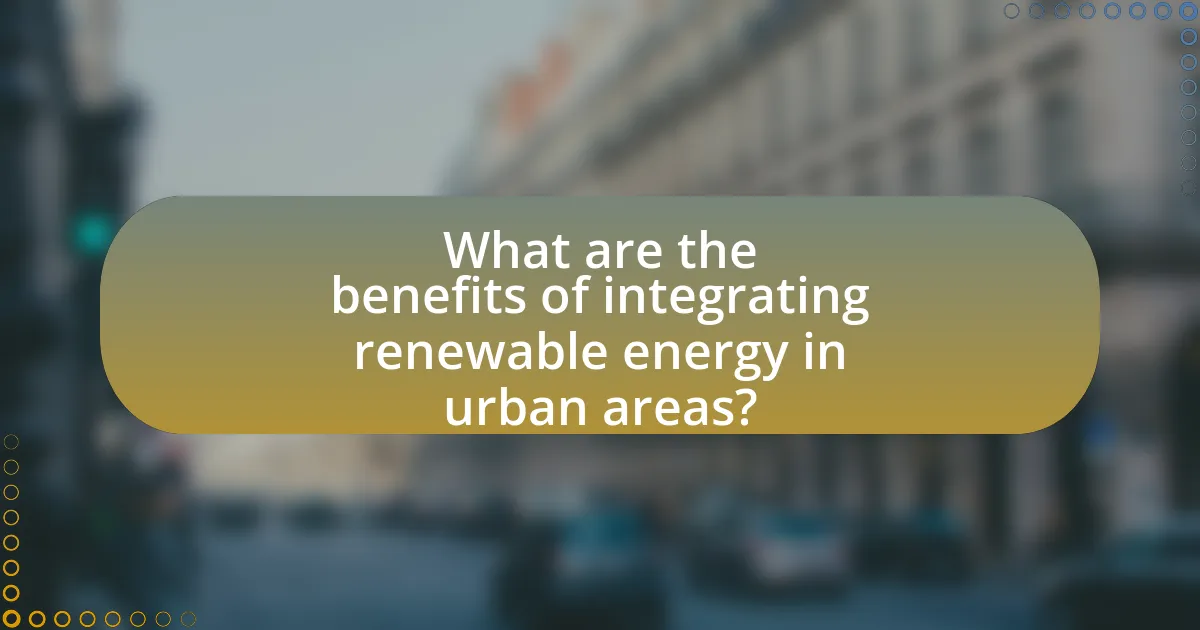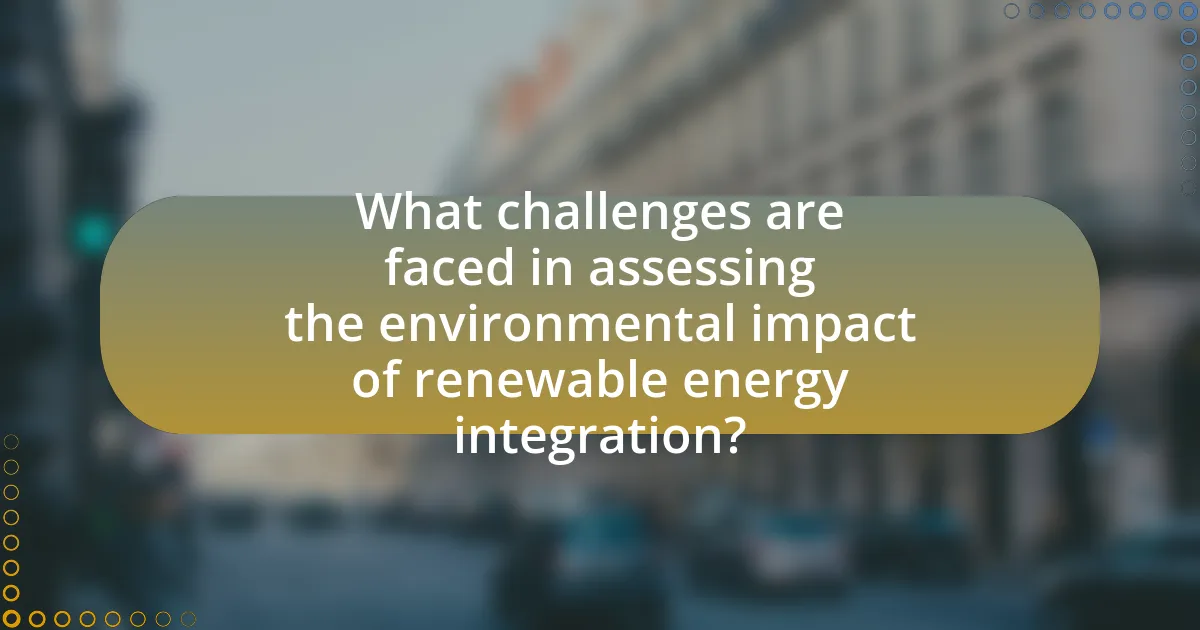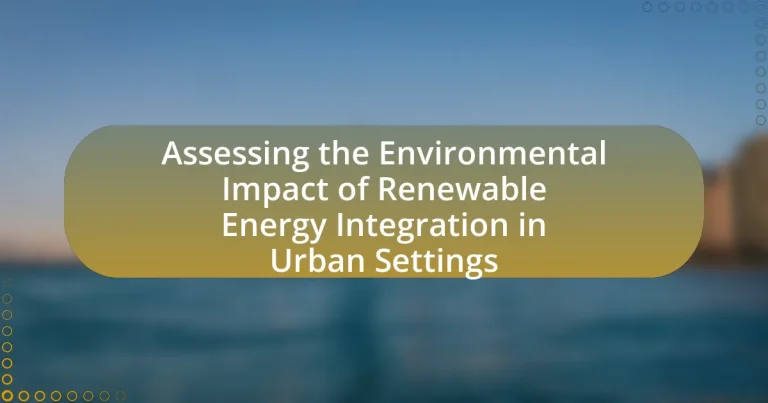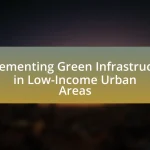The article focuses on assessing the environmental impact of renewable energy integration in urban settings, highlighting its predominantly positive effects, such as reduced greenhouse gas emissions and improved air quality. It discusses how renewable technologies like solar panels and wind turbines can significantly decrease reliance on fossil fuels, leading to enhanced energy efficiency and lower energy costs. Key environmental factors influenced by this integration include improved biodiversity and public health outcomes. The article also addresses the importance of assessing environmental impacts, the methodologies used, and the role of stakeholder perspectives in shaping effective assessments, while outlining the economic advantages and challenges associated with renewable energy projects in urban areas.

What is the Environmental Impact of Renewable Energy Integration in Urban Settings?
The environmental impact of renewable energy integration in urban settings is predominantly positive, leading to reduced greenhouse gas emissions and improved air quality. For instance, the deployment of solar panels and wind turbines in cities can significantly decrease reliance on fossil fuels, which are major contributors to urban air pollution. A study by the International Renewable Energy Agency (IRENA) found that transitioning to renewable energy sources could reduce global CO2 emissions by up to 70% by 2050. Additionally, urban areas that adopt renewable energy technologies often experience enhanced energy efficiency and lower energy costs, further contributing to sustainable urban development.
How does renewable energy integration affect urban environments?
Renewable energy integration positively affects urban environments by reducing greenhouse gas emissions and improving air quality. The implementation of solar panels, wind turbines, and other renewable technologies in cities leads to a significant decrease in reliance on fossil fuels, which are major contributors to urban pollution. For instance, a study by the International Renewable Energy Agency (IRENA) found that increasing the share of renewables in urban energy systems can reduce carbon emissions by up to 70% by 2050. Additionally, renewable energy sources often require less water than traditional energy sources, which is crucial for urban areas facing water scarcity. This transition not only enhances sustainability but also promotes public health by decreasing respiratory diseases linked to air pollution.
What are the key environmental factors influenced by renewable energy in cities?
The key environmental factors influenced by renewable energy in cities include reduced greenhouse gas emissions, improved air quality, and enhanced biodiversity. Renewable energy sources, such as solar and wind, significantly lower carbon dioxide emissions compared to fossil fuels; for instance, a study by the International Renewable Energy Agency found that transitioning to renewable energy could reduce global CO2 emissions by up to 70% by 2050. Improved air quality results from decreased reliance on fossil fuels, leading to lower levels of pollutants like sulfur dioxide and nitrogen oxides, which are linked to respiratory diseases. Additionally, the integration of green spaces and renewable energy infrastructure can promote biodiversity by providing habitats for various species, as evidenced by urban planning initiatives that incorporate solar panels and green roofs, which support local ecosystems.
How do urban ecosystems respond to renewable energy initiatives?
Urban ecosystems respond positively to renewable energy initiatives by experiencing improved air quality, reduced greenhouse gas emissions, and enhanced biodiversity. The implementation of renewable energy sources, such as solar panels and wind turbines, decreases reliance on fossil fuels, which in turn lowers pollutants like nitrogen oxides and particulate matter. For instance, a study by the National Renewable Energy Laboratory found that transitioning to renewable energy can reduce urban carbon emissions by up to 80% by 2050. Additionally, integrating green infrastructure, such as green roofs and urban forests alongside renewable energy projects, fosters habitats for various species, thereby promoting biodiversity. This multifaceted response illustrates the significant environmental benefits that urban ecosystems can gain from renewable energy initiatives.
Why is assessing environmental impact crucial for urban renewable energy projects?
Assessing environmental impact is crucial for urban renewable energy projects because it ensures that these initiatives do not adversely affect local ecosystems and communities. Urban areas often have complex environmental dynamics, and understanding these impacts helps in mitigating potential harm, such as habitat destruction or pollution. For instance, a study by the National Renewable Energy Laboratory found that careful site selection and environmental assessments can reduce negative effects on biodiversity by up to 50%. This assessment process also aids in compliance with regulations and enhances public acceptance, ultimately leading to more sustainable and effective energy solutions.
What methodologies are used to assess environmental impacts?
Methodologies used to assess environmental impacts include Environmental Impact Assessment (EIA), Life Cycle Assessment (LCA), and Strategic Environmental Assessment (SEA). EIA evaluates the potential environmental effects of proposed projects before they are carried out, ensuring that decision-makers consider environmental impacts. LCA analyzes the environmental aspects and potential impacts associated with a product or service throughout its life cycle, from raw material extraction to disposal. SEA is a systematic process for evaluating the environmental consequences of proposed policies, plans, or programs, integrating environmental considerations into decision-making. These methodologies are widely recognized and utilized in various sectors to ensure sustainable development and minimize negative environmental effects.
How do stakeholder perspectives shape impact assessments?
Stakeholder perspectives significantly shape impact assessments by influencing the identification of relevant issues, priorities, and potential impacts. Stakeholders, including local communities, government agencies, and environmental organizations, provide diverse viewpoints that highlight specific concerns and values related to renewable energy projects. For instance, a study by the International Association for Impact Assessment found that incorporating stakeholder input leads to more comprehensive assessments, as it captures a wider range of environmental, social, and economic factors. This collaborative approach ensures that the assessments reflect the interests and needs of those affected, ultimately leading to more informed decision-making and enhanced project outcomes.

What are the benefits of integrating renewable energy in urban areas?
Integrating renewable energy in urban areas significantly reduces greenhouse gas emissions, contributing to climate change mitigation. For instance, cities that adopt solar and wind energy can decrease their carbon footprint by up to 70%, as evidenced by a study from the International Renewable Energy Agency, which highlights that urban areas are responsible for approximately 70% of global CO2 emissions. Additionally, renewable energy enhances energy security and resilience, as urban centers can diversify their energy sources and reduce dependence on fossil fuels. This transition not only promotes public health by improving air quality but also stimulates local economies through job creation in the renewable energy sector, with the U.S. Bureau of Labor Statistics projecting that jobs in solar and wind energy will grow by 20% and 61%, respectively, from 2019 to 2029.
How does renewable energy integration contribute to sustainability in cities?
Renewable energy integration contributes to sustainability in cities by reducing greenhouse gas emissions and promoting energy efficiency. By incorporating sources such as solar, wind, and hydropower, cities can significantly decrease their reliance on fossil fuels, which are major contributors to climate change. For instance, a study by the International Renewable Energy Agency (IRENA) found that transitioning to renewable energy could reduce global CO2 emissions by up to 70% by 2050. Additionally, renewable energy systems often require less water for operation compared to traditional energy sources, thus conserving vital water resources in urban areas. This integration not only enhances energy security but also fosters economic growth through job creation in the renewable sector, further supporting sustainable urban development.
What role does renewable energy play in reducing urban carbon footprints?
Renewable energy significantly reduces urban carbon footprints by replacing fossil fuels with cleaner energy sources. This transition leads to lower greenhouse gas emissions, as renewable energy technologies like solar, wind, and hydroelectric power produce little to no emissions during operation. For instance, a study by the International Renewable Energy Agency (IRENA) found that increasing the share of renewables in the energy mix can reduce carbon dioxide emissions by up to 70% in urban areas. Additionally, cities that invest in renewable energy infrastructure often experience improved air quality and public health outcomes, further enhancing the environmental benefits of this energy transition.
How can renewable energy improve urban air quality?
Renewable energy can improve urban air quality by significantly reducing emissions of harmful pollutants. Transitioning from fossil fuels to renewable sources like solar, wind, and hydroelectric power decreases the release of nitrogen oxides, sulfur dioxide, and particulate matter, which are major contributors to urban air pollution. For instance, a study by the International Renewable Energy Agency (IRENA) found that increasing the share of renewables in the energy mix can lead to a reduction of air pollutants by up to 70% in urban areas. This reduction not only enhances public health by lowering respiratory and cardiovascular diseases but also contributes to overall environmental sustainability.
What economic advantages arise from renewable energy integration in urban settings?
Renewable energy integration in urban settings provides significant economic advantages, including job creation, reduced energy costs, and increased property values. The transition to renewable energy sources, such as solar and wind, generates employment opportunities in installation, maintenance, and manufacturing sectors. For instance, the Solar Foundation’s National Solar Jobs Census reported that the solar industry employed over 250,000 workers in the United States in 2019, highlighting the job growth potential.
Additionally, renewable energy can lower energy expenses for consumers and businesses by reducing reliance on fossil fuels, which are subject to price volatility. According to the International Renewable Energy Agency, the cost of solar photovoltaic systems has decreased by over 80% since 2010, leading to lower electricity bills for urban residents.
Furthermore, properties equipped with renewable energy systems often see an increase in market value. A study by the U.S. Department of Energy found that homes with solar panels sold for an average of $15,000 more than comparable homes without them. This increase in property values contributes to higher tax revenues for local governments, further enhancing the economic benefits of renewable energy integration in urban areas.
How does renewable energy create job opportunities in cities?
Renewable energy creates job opportunities in cities by driving the development and installation of clean energy technologies, which require a skilled workforce. For instance, the solar and wind energy sectors have seen significant growth, leading to the creation of jobs in manufacturing, installation, maintenance, and administration. According to the International Renewable Energy Agency (IRENA), the renewable energy sector employed over 11 million people globally in 2018, with a substantial portion of these jobs located in urban areas where projects are concentrated. This trend is expected to continue as cities invest in sustainable infrastructure, further enhancing local employment opportunities.
What are the cost savings associated with renewable energy adoption?
Renewable energy adoption leads to significant cost savings primarily through reduced energy bills and lower operational costs. For instance, solar energy systems can decrease electricity expenses by up to 70% over their lifespan, as reported by the U.S. Department of Energy. Additionally, renewable energy sources often have lower maintenance costs compared to traditional fossil fuels, with wind turbines requiring less frequent repairs and maintenance, resulting in further savings. Furthermore, the declining costs of renewable technologies, such as solar panels, which have dropped by over 80% since 2010, enhance the economic viability of these energy sources, making them more accessible and cost-effective for consumers and businesses alike.

What challenges are faced in assessing the environmental impact of renewable energy integration?
Assessing the environmental impact of renewable energy integration faces several challenges, including data availability, variability in energy sources, and the complexity of ecological interactions. Data availability is often limited, making it difficult to obtain accurate baseline measurements and long-term impact assessments. Variability in renewable energy sources, such as solar and wind, leads to fluctuating outputs that complicate the evaluation of their environmental effects over time. Additionally, the complexity of ecological interactions means that integrating renewable energy can have unforeseen consequences on local ecosystems, which are difficult to predict and quantify. These challenges hinder comprehensive assessments and informed decision-making regarding renewable energy projects in urban settings.
What are the common barriers to effective impact assessment?
Common barriers to effective impact assessment include lack of data, insufficient stakeholder engagement, and inadequate methodologies. Lack of data hinders the ability to accurately measure environmental impacts, as comprehensive and reliable data is essential for informed assessments. Insufficient stakeholder engagement can lead to overlooked perspectives and concerns, which may result in incomplete evaluations of potential impacts. Inadequate methodologies can produce unreliable results, as they may not account for the complexities of urban environments or the specific characteristics of renewable energy projects. These barriers collectively impede the effectiveness of impact assessments in the context of renewable energy integration in urban settings.
How do regulatory frameworks influence assessment processes?
Regulatory frameworks significantly influence assessment processes by establishing the legal and procedural guidelines that govern how environmental impacts are evaluated. These frameworks dictate the methodologies, criteria, and standards that must be adhered to during assessments, ensuring consistency and compliance with environmental protection goals. For instance, the National Environmental Policy Act (NEPA) in the United States requires federal agencies to assess the environmental effects of their proposed actions before making decisions, thereby shaping the assessment process for renewable energy projects. This legal requirement ensures that potential impacts are systematically identified and mitigated, promoting sustainable development in urban settings.
What data limitations hinder accurate environmental impact evaluations?
Data limitations that hinder accurate environmental impact evaluations include insufficient temporal and spatial resolution, lack of comprehensive datasets, and inadequate modeling techniques. Insufficient temporal resolution can lead to an inability to capture seasonal variations in environmental factors, while lack of comprehensive datasets may result in missing critical variables that influence environmental outcomes. Inadequate modeling techniques can further complicate the evaluation process by failing to accurately simulate complex interactions within urban ecosystems. These limitations can lead to biased or incomplete assessments, ultimately affecting decision-making regarding renewable energy integration in urban settings.
How can urban planners overcome these challenges?
Urban planners can overcome challenges related to renewable energy integration by implementing comprehensive strategies that include stakeholder engagement, data-driven decision-making, and adaptive policy frameworks. Engaging stakeholders, such as community members and local businesses, fosters collaboration and ensures that diverse perspectives are considered, which can lead to more effective solutions. Data-driven decision-making allows planners to analyze environmental impacts accurately, utilizing tools like Geographic Information Systems (GIS) to assess land use and energy needs. Adaptive policy frameworks enable planners to adjust strategies based on real-time feedback and changing conditions, ensuring that urban environments can effectively integrate renewable energy sources while minimizing negative environmental impacts. These approaches are supported by case studies demonstrating successful renewable energy projects in urban settings, such as the integration of solar panels in San Diego, which resulted in a significant reduction in greenhouse gas emissions.
What best practices can be implemented for effective assessments?
Effective assessments can be achieved by implementing a structured framework that includes clear objectives, stakeholder engagement, and data-driven methodologies. Establishing clear objectives ensures that the assessment aligns with specific goals, such as measuring the environmental impact of renewable energy integration. Engaging stakeholders, including community members and experts, fosters transparency and inclusivity, which enhances the credibility of the assessment process. Utilizing data-driven methodologies, such as life cycle assessments and environmental impact assessments, provides a robust basis for evaluating the potential effects of renewable energy projects. These practices are supported by research indicating that structured assessments lead to more reliable and actionable outcomes in urban environmental contexts.
How can technology enhance the assessment of environmental impacts?
Technology enhances the assessment of environmental impacts by utilizing advanced data collection and analysis tools, such as remote sensing, Geographic Information Systems (GIS), and machine learning algorithms. These technologies enable precise monitoring of environmental changes, allowing for real-time data acquisition and spatial analysis of urban settings. For instance, remote sensing can track land use changes and vegetation cover, while GIS can visualize and analyze the spatial distribution of environmental factors. Additionally, machine learning can predict potential impacts based on historical data, improving decision-making processes. Studies have shown that integrating these technologies can lead to more accurate assessments, as evidenced by a 2020 research published in the Journal of Environmental Management, which demonstrated that GIS-based assessments improved the accuracy of environmental impact evaluations by 30% compared to traditional methods.
What are the future trends in assessing environmental impacts of renewable energy in urban settings?
Future trends in assessing environmental impacts of renewable energy in urban settings include the integration of advanced data analytics, real-time monitoring systems, and life cycle assessment (LCA) methodologies. These approaches enable cities to evaluate the ecological footprint of renewable energy projects more accurately and efficiently. For instance, the use of Geographic Information Systems (GIS) combined with big data allows for spatial analysis of energy production and consumption patterns, facilitating targeted interventions. Additionally, the adoption of machine learning algorithms can enhance predictive modeling of environmental impacts, leading to more informed decision-making. Research indicates that cities employing these technologies can achieve up to a 30% reduction in greenhouse gas emissions by optimizing renewable energy deployment strategies.
How will advancements in technology shape future assessments?
Advancements in technology will significantly enhance future assessments by enabling more accurate data collection and analysis methods. For instance, the integration of artificial intelligence and machine learning can process vast amounts of environmental data, allowing for real-time monitoring of renewable energy impacts in urban settings. Additionally, remote sensing technologies, such as satellite imagery and drones, provide detailed spatial data that can improve the understanding of how renewable energy systems affect local ecosystems. Research has shown that these technologies can increase the precision of environmental assessments, leading to more informed decision-making regarding urban energy policies.
What role will community engagement play in future assessments?
Community engagement will play a crucial role in future assessments of renewable energy integration in urban settings by ensuring that local perspectives and needs are incorporated into decision-making processes. Engaging communities fosters collaboration, enhances transparency, and builds trust, which are essential for the successful implementation of renewable energy projects. Research indicates that projects with strong community involvement are more likely to achieve long-term sustainability and public support, as evidenced by case studies showing increased acceptance and participation in energy initiatives when local stakeholders are actively involved.
What practical steps can urban planners take to ensure effective renewable energy integration?
Urban planners can ensure effective renewable energy integration by implementing comprehensive zoning regulations that prioritize renewable energy infrastructure. This includes designating specific areas for solar farms, wind turbines, and energy storage systems, which facilitates the development of these technologies in urban settings. Additionally, planners should incorporate renewable energy considerations into building codes, mandating energy-efficient designs and the installation of solar panels in new constructions.
Furthermore, engaging with local communities to promote awareness and acceptance of renewable energy projects is crucial. Studies show that community involvement can lead to higher adoption rates of renewable technologies. For instance, a report by the International Renewable Energy Agency highlights that public acceptance is a key factor in the successful deployment of renewable energy projects.
Lastly, urban planners should collaborate with utility companies to develop smart grid technologies that enhance the integration of renewable energy sources into the existing energy infrastructure, ensuring reliability and efficiency in energy distribution.


